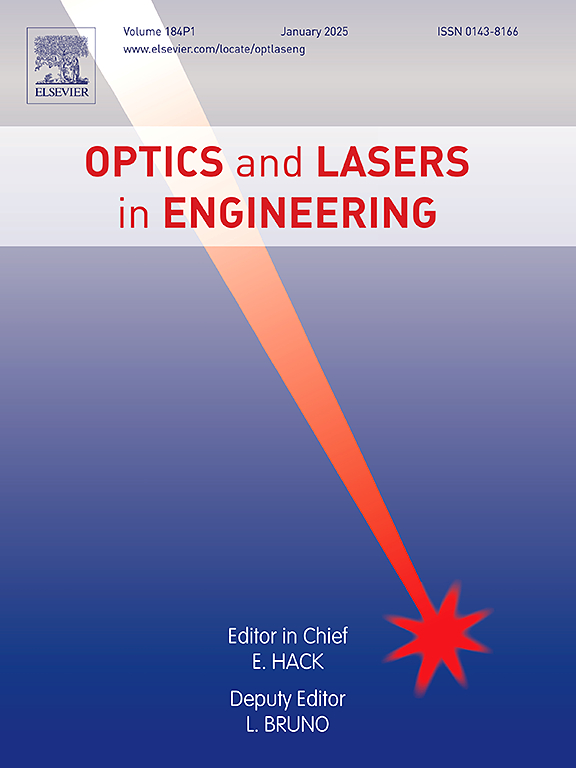Structured light vision-based online quality inspection of weld formation for arc-welded joints in steel
IF 3.5
2区 工程技术
Q2 OPTICS
引用次数: 0
Abstract
The current non-destructive testing for the quality of weld formation remains predominantly dependent on low-efficiency, low-intelligence and low-precision manual evaluation, which seriously impedes the construction of the fully automated welding production system, ranging from assembly to quality inspection. To overcome this limitation, a novel online quality inspection technology of weld formation for arc-welded joints in steel is proposed. The establishment of the 3D coordinate recognition model for quality inspection is prioritized to empower the technology to perceive spatial information, merging the complex task of measuring weld geometrical dimensions and the cumbersome process of identifying, classifying, locating and quantitatively evaluating weld geometrical imperfections into a unified structured light vision scanning procedure. During the scanning operation, the image processing algorithm integrating YOLOv5 with the innovative spatial distance judgement method (SDJM) performs autonomous weld classification while simultaneously measuring weld geometrical dimensions, such as weld width, reinforcement and leg sizes of fillet weld. Crucially, the algorithm extends beyond mere weld profile dimension monitoring to achieve precise detection, localization, and classification of geometrical imperfections, including undercut, overlap, excess weld metal, incompletely filled groove, linear misalignment, excessive asymmetry fillet weld and excessive convexity, with autonomous quality level evaluation against the ISO 5817:1992 standard. Experimental validation confirms that the proposed technology is capable of measuring weld geometrical dimensions with the accuracy of 10−2 mm, achieving the 100 % evaluation rate for quality levels of geometrical imperfections, and reconstructing 3D morphology consistent with the actual weld, which satisfies the requirements for online quality inspection of weld formation in automated welding production lines.
基于结构光视觉的钢弧焊焊缝成形质量在线检测
目前对焊缝成形质量的无损检测主要依赖于低效率、低智能、低精度的人工评定,严重阻碍了从装配到质量检测的全自动化焊接生产系统的建设。为了克服这一局限性,提出了一种新型的钢弧焊接头焊缝成形在线质量检测技术。重点建立质量检测三维坐标识别模型,赋予该技术感知空间信息的能力,将复杂的焊缝几何尺寸测量任务和繁琐的焊缝几何缺陷识别、分类、定位和定量评价过程融合到统一的结构光视觉扫描过程中。在扫描过程中,图像处理算法将YOLOv5与创新的空间距离判断方法(SDJM)相结合,进行焊缝自主分类,同时测量焊缝几何尺寸,如焊缝宽度、补强、角焊缝支腿尺寸等。至关重要的是,该算法超越了单纯的焊缝外形尺寸监测,可以实现精确的检测、定位和几何缺陷分类,包括下切、重叠、多余的焊缝金属、不完全填充的坡口、线性错位、过度不对称的角焊缝和过度的凹凸,并根据ISO 5817:1992标准进行自主质量等级评估。实验验证表明,该技术能够以10 ~ 2mm的精度测量焊缝几何尺寸,对几何缺陷质量等级的评定率达到100%,并重建与实际焊缝一致的三维形貌,满足自动化焊接生产线焊缝成形在线质量检测的要求。
本文章由计算机程序翻译,如有差异,请以英文原文为准。
求助全文
约1分钟内获得全文
求助全文
来源期刊

Optics and Lasers in Engineering
工程技术-光学
CiteScore
8.90
自引率
8.70%
发文量
384
审稿时长
42 days
期刊介绍:
Optics and Lasers in Engineering aims at providing an international forum for the interchange of information on the development of optical techniques and laser technology in engineering. Emphasis is placed on contributions targeted at the practical use of methods and devices, the development and enhancement of solutions and new theoretical concepts for experimental methods.
Optics and Lasers in Engineering reflects the main areas in which optical methods are being used and developed for an engineering environment. Manuscripts should offer clear evidence of novelty and significance. Papers focusing on parameter optimization or computational issues are not suitable. Similarly, papers focussed on an application rather than the optical method fall outside the journal''s scope. The scope of the journal is defined to include the following:
-Optical Metrology-
Optical Methods for 3D visualization and virtual engineering-
Optical Techniques for Microsystems-
Imaging, Microscopy and Adaptive Optics-
Computational Imaging-
Laser methods in manufacturing-
Integrated optical and photonic sensors-
Optics and Photonics in Life Science-
Hyperspectral and spectroscopic methods-
Infrared and Terahertz techniques
 求助内容:
求助内容: 应助结果提醒方式:
应助结果提醒方式:


